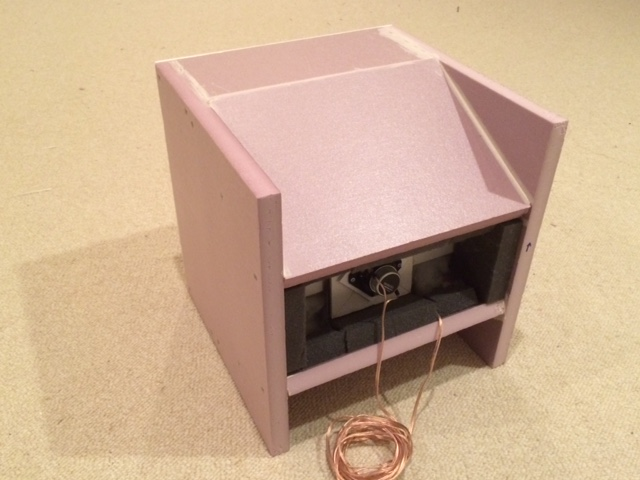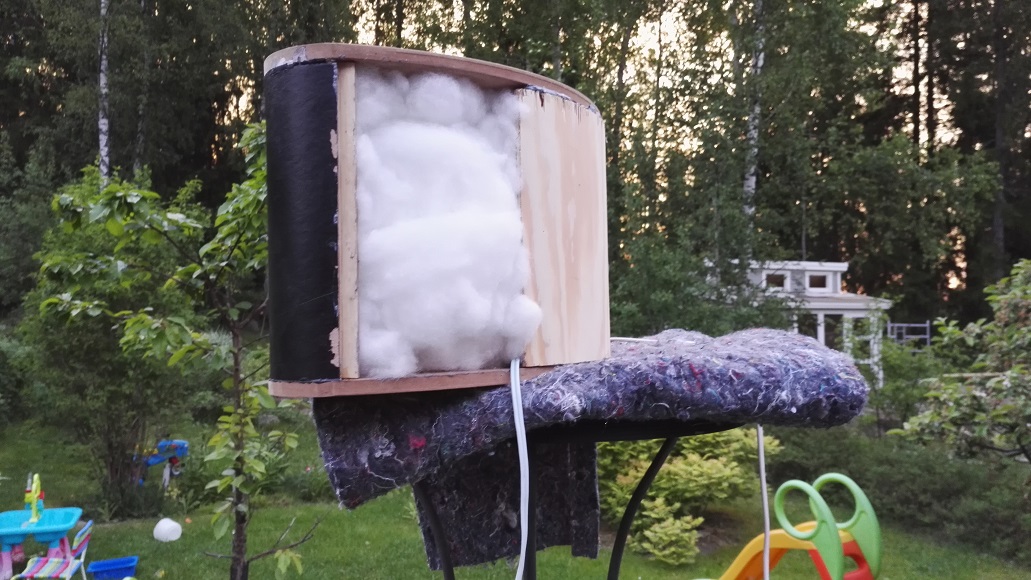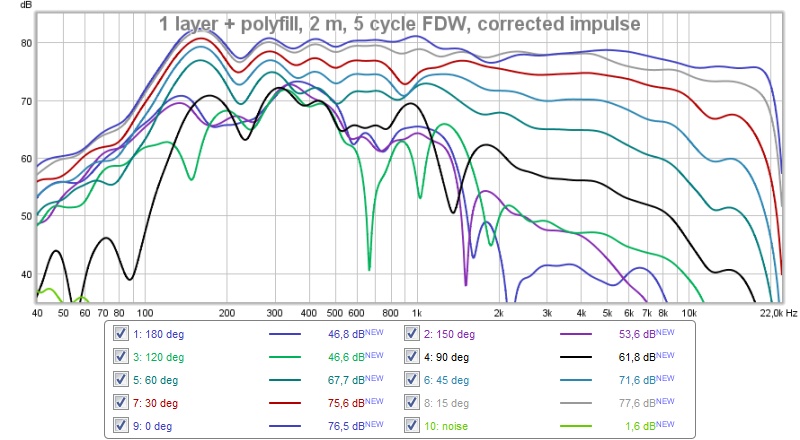This speaker, like all synergies is very impressive sounding. One of the few speakers that I would say sounds "stunning". You know a stunning speaker when you hear it: you are stunned and stopped in your tracks and perk your ears and listen, and want to hear more and more, you would give up sleep to hear it more.
The larger Trynergy that I have and a much larger one with a 30in wide mouth have the advantage of higher sensitvity, but overall sound quality is still superb with this speaker. Best to ask Bushmeister as he has built two versions and it appears to be his current reference speaker , beating out a very expensive Volt 3-way monitor.
The larger Trynergy that I have and a much larger one with a 30in wide mouth have the advantage of higher sensitvity, but overall sound quality is still superb with this speaker. Best to ask Bushmeister as he has built two versions and it appears to be his current reference speaker , beating out a very expensive Volt 3-way monitor.
I would say that, beyond higher sensitivity and perhaps lower bass extension, the larger the horn the easier the integration into the room. The bigger horn controls reflections better and limits them to lower frequencies. You especially need to consider this in a very small room which unfortunately has less room for large horns, but at least with Synergy you will need only one horn per side.
Its not a question of culture or affluence but a concept of acoustics. A small room is one in which the reflections from the boundaries arrive earlier than the Haas limit. Reflections from floor and ceiling are almost always going to be early in a home and thus all rooms in a home are small compared to a public venue, some being smaller than others. An early reflection affects the perception of the direct sound; a late reflection contributes to ambience and envelopment. Even large speakers in small room may benefit from acoustic absorption panels at reflection points; large horn speakers less so than small horn speakers.
Sure, I get that fysics dictate what a small room is. I however disagree about the cultural aspect. Houses are build differently in different countries, regions and throughout the ages, therefore the acoustical effects will also be not the same. In my home I have brick walls a solid floor and a high wooden ceiling, which will behave differently than the same size room in a full wooden house.
Btw, if I look at the Haas effect, I doudt that even 1% of forum members have a large enough room.. or am I missing something here? I also suspect that this effect is highly frequency dependent?
Btw, if I look at the Haas effect, I doudt that even 1% of forum members have a large enough room.. or am I missing something here? I also suspect that this effect is highly frequency dependent?
You are right almost all of us have rooms considered acoustically small because a room has to be large indeed to be large acoustically. I'd advise giving priority to treating the earliest reflections since complete treatment is usually neither practical nor desirable. A larger horn can help by reducing the strength of those earliest reflections and limiting them to lower frequencies. A corner horn can eliminate near side wall reflections and if the room is large enough then the far side wall reflection will be late enough to not need treatment. But the horn has to be tall as well as wide to help with floor and ceiling reflections.
Hi 4real,
Last December xrk971 and i had a listen in a Dutch living room with brick walls solid wooden floor and a high metal ceiling, below is acoustic performance at listening position both speakers fired, speakers are different than this thread and the look at link you provided but their footprint on floor is smaller than most, btw owner wesayso also helped bushmeister a lot to get DSP correction to high performance.

The making of: The Two Towers (a 25 driver Full Range line array)
Last December xrk971 and i had a listen in a Dutch living room with brick walls solid wooden floor and a high metal ceiling, below is acoustic performance at listening position both speakers fired, speakers are different than this thread and the look at link you provided but their footprint on floor is smaller than most, btw owner wesayso also helped bushmeister a lot to get DSP correction to high performance.

The making of: The Two Towers (a 25 driver Full Range line array)
That does look pretty good!
Well, simply put, I don't really want use huge horns in my living room, so these seem like a very nice compromise.
One thing I noticed is that a 1.4" horn is used with a 2.5" fullrange driver. I'd like to use a 2" horn because I might want to switch to a 2" BMS coax compression driver if it all works out. What would be the effect of the larger throat (on the fullrange driver)? How much will that affect HF?
Well, simply put, I don't really want use huge horns in my living room, so these seem like a very nice compromise.
One thing I noticed is that a 1.4" horn is used with a 2.5" fullrange driver. I'd like to use a 2" horn because I might want to switch to a 2" BMS coax compression driver if it all works out. What would be the effect of the larger throat (on the fullrange driver)? How much will that affect HF?
Last edited:
After reading though the whole thing I’d like to ask the people that build or heard these: how much of a difference is there compared to a “big” synergy horn that covers to about 300~400Hz horn loading? I really like the look of the Davone Ray posted way back here and I think it would make for a very nice enclosure for a small synergy horn.
@Sheldon owns Unity horns that look like this:
(These aren't his exactly, this is a different forum member in PDX, but you get the general idea.)
I owned Gedlee Summas that look like this:

On the forum, Sheldon said something interesting. He said that There wasn't a big difference between running the Unity horn as a two-way or as a three way.
This was surprising to me, because the waveguide on the Unity horn plays down to 350Hz, whereas the waveguide on the Summa plays down to 900Hz.
Determined to figure out what the heck was going on, I traded in my Mazda6 for a CX5, and I rented a set of SH50s, and I brought them to Sheldon's house to do a head-to-head comparison. (In hindsight, a dumb idea; the Mazda CX5 is a snoozefest and I miss my Mazda6, but I digress...)
To my ears, the larger waveguide of the SH50 makes an audible difference in the imaging. It seems to 'get the room out of the equation' better. Like a giant set of headphones.
The Lambda Unity *does* sound quite similar to the Gedlee Summas.
But there's a zillion factors that also come into play here:
1) my amps are garbage and Sheldon's are nice
2) IIRC, Sheldon was using a very nice set of TAD compression drivers. The SH50 uses a BMS compression driver and the Gedlee Summa uses a B&C compression driver.
3) I didn't haul the Summa over, so I was going off my own memory of how it sounds in my own room
4) IMHO, the biggest factor overall is the xover. The crossover in the SH50 is the result of years of refinement, the xover in the Lambda Unity predates it by about six years.
All of this is kinda academic though. If you want a set of Synergy Horns that don't dominate your room, just copy one of Bill's designs. If I had the time to build a speaker in 2017, I would do that.
@Sheldon owns Unity horns that look like this:
Are these the ones?
My wife even thinks they're beautiful, which is more or less a mandate to build a pair of Bill's newest horns (as planned) and give them a similar look.
@Sheldon owns Unity horns that look like this:
<snip>
Bills designs: link? Or the design on page 1 of this thread. What's the best larger design out there?
Bills designs: link? Or the design on page 1 of this thread. What's the best larger design out there?
I think he means the Small Syns. But neither this thread nor the Small Syns are large designs. They are meant be be relatively small
I'm wondering if there is another solution: what if you would take the simple 2-way design that is proposed here, and make it an acoustic resistance box by making some stuffed slots in the side panels. That would also take care of the lower down directivity, but does not need a box that is much wider or higher than the horn itself is.
I went with a big conical horn, a single 12PE32 12" driver for 110-500, entering near the throat in a 180 sq. cm. port. The cone throat is 25sq.cm area.
Did some tests with:
- Faital Pro 3Fe25 as full range. Not enough highs.
- Faital Pro 3Fe25 + Seas 27TDC tweeter suspended in center of the horn mouth. Sound was good.
- Faital Pro 3Fe25 + BMS 4524 in a OS horn. Sound is even better.
- today I bought the SB Acoustic SB65WBAC25-4. I will try it as fullrange, I want a simple 2way.
For subwoofers, I have sealed box but sometime I feel they don't integrate good with the horn loaded mid-bass. I am assembling a TH with B&C 10CL51 now, in simulation it looks good.
Did some tests with:
- Faital Pro 3Fe25 as full range. Not enough highs.
- Faital Pro 3Fe25 + Seas 27TDC tweeter suspended in center of the horn mouth. Sound was good.
- Faital Pro 3Fe25 + BMS 4524 in a OS horn. Sound is even better.
- today I bought the SB Acoustic SB65WBAC25-4. I will try it as fullrange, I want a simple 2way.
For subwoofers, I have sealed box but sometime I feel they don't integrate good with the horn loaded mid-bass. I am assembling a TH with B&C 10CL51 now, in simulation it looks good.
I think he means the Small Syns. But neither this thread nor the Small Syns are large designs. They are meant be be relatively small
I'm wondering if there is another solution: what if you would take the simple 2-way design that is proposed here, and make it an acoustic resistance box by making some stuffed slots in the side panels. That would also take care of the lower down directivity, but does not need a box that is much wider or higher than the horn itself is.
Not sure of what you had in mind but a made a foam Trynergy with woofer rear cone output going out a slightly damped open back. Bass was quite nice.
Presenting the Trynergy - a full range tractrix synergy.

I went with a big conical horn, a single 12PE32 12" driver for 110-500, entering near the throat in a 180 sq. cm. port. The cone throat is 25sq.cm area.
Did some tests with:
- Faital Pro 3Fe25 as full range. Not enough highs.
- Faital Pro 3Fe25 + Seas 27TDC tweeter suspended in center of the horn mouth. Sound was good.
- Faital Pro 3Fe25 + BMS 4524 in a OS horn. Sound is even better.
- today I bought the SB Acoustic SB65WBAC25-4. I will try it as fullrange, I want a simple 2way.
For subwoofers, I have sealed box but sometime I feel they don't integrate good with the horn loaded mid-bass. I am assembling a TH with B&C 10CL51 now, in simulation it looks good.
A TH is a good idea for powerful bass. The hardest part is getting it to gonhigh enogh to cross with horn at 120Hz or so. A front loaded bass horn is better here as can go up to 300Hz easy.
Not sure of what you had in mind but a made a foam Trynergy with woofer rear cone output going out a slightly damped open back. Bass was quite nice.
Presenting the Trynergy - a full range tractrix synergy.

Yes, something like that. Did you do polars of that one? In my idea the dampend holes would be on the sides though.
That sounds a little like my synergy experiment:Yes, something like that. Did you do polars of that one? In my idea the dampend holes would be on the sides though.



/Anton
- Home
- Loudspeakers
- Multi-Way
- A Bookshelf Multi-Way Point-Source Horn